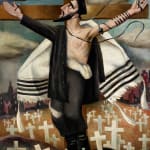Artist Emmanuel Levy
Accession number 2004-2
Emmanuel Levy's ‘Crucifixion’, like Marc Chagall’s ‘White Crucifixion’, was a personal protest against Jewish persecution in mainland Europe during the Nazi era. As the Ben Uri Collection entry notes Christ is presented “as an orthodox Jew with his Tallit (prayer shawl) and prayer phylacteries.” “The label ‘Jude’ in blood red above and the rows of white crosses (traditionally marking Christian graves) symbolise the many Jews who were being killed at the time.”
The crucifixions of Levy and Chagall “symbolised the Nazi's Jewish victims in order to remind Christians that Christ was a Jew and they should stop persecuting his brothers”. Such persecution remains an ever-present danger for migrants, whether from the dangers of crossing vast expanses of ocean in flimsy crafts or from the scapegoating of those who are ‘other’ by those in receiving communities.
According to René Girard’s mimetic theory, human beings imitate each other, and this gives rise to rivalries and violent conflicts. Such conflicts are partially solved by a scapegoat mechanism. Scapegoating alludes to the ritual proscribed in Leviticus 16 where communal sins were metaphorically imposed upon a he-goat, and the goat was sent out into the desert to die. The person that receives the communal violence is a ‘scapegoat’ in this sense: his or her death or expulsion being used as a regeneration of communal peace and restoration of relationships.
This mechanism, which is endemic in human societies and applied with particular frequency to migrants, is exposed, subverted and undermined by both Judaism and Christianity in order that scapegoating as a practice be ended. Crucifixion paintings like those by Levy and Chagall also play their part in exposing and subverting the scapegoating mechanism.
Further images
Provenance
acquired at Bonhams through the generous assistance of the members of the Board of the Ben Uri Gallery 2004Exhibitions
2004
The Modern and the New: An Examination of the Permanent Collection alongside New Works by Invited British, European and American Jewish Artists
Ben Uri Gallery - The London Jewish Museum of Art
2006
Recent Acquisitions 2001-2006
Ben Uri Gallery - The London Jewish Museum of Art
2009
Homeless & Hidden 2: World Class Collection Homeless & Hidden
Ben Uri Gallery
2010
Apocalypse: unveiling a lost masterpiece by Marc Chagall and 50 selected masterworks from the Ben Uri Collection
Osborne Samuel
2010
Cross Purposes: Shock and Contemplation in Images of the Crucifixion
Ben Uri Gallery
2014
Made in Manchester: The Art of Emmanuel Levy (1900-1986)
Manchester Jewish Museum
2015
Out of Chaos – Ben Uri: 100 Years in London
Somerset House
2018
Acquisitions and Long-Term Loan Highlights Since 2001
Ben Uri Gallery
2023
Art, Identity, Migration - Ben Uri at the London Art Fair
Business Design Centre
2023
A Brush with Evil: Peter Howson's Holocaust Crowd Scene II
Ben Uri Gallery
Literature
Monica Bohm-Duchen, 'A Jewish Jesus: Monica Bohm-Duchen explores Christian imagery in the work of Jewish artists' Art and Christianity (Winter 2020) pp. 2-9.;Sarah MacDougall, 'Emmanuel Levy', Encylopedia of the Bible and its Reception, (de Gruyter online, 2018);
Rachel Dickson and Sarah MacDougall, eds., Out of Chaos: Ben Uri; 100 Years in London (London: Ben Uri Gallery, 2015) pp. 96-97.;
Sarah MacDougall, Made in Manchester: the Art of Emmanuel Levy (Exhibition texts, Jewish Museum Manchester/Ben Uri Gallery, 2013);
David Breuer-Weil, 'Emmanuel Levy, Crucifixion, 1942' in Cross Purposes: Shock and Contemplation in Images of the Crucifixion (ed. N. Hepburn, exh. cat, Mascalls Gallery/Ben Uri Gallery; London 2010), p. 35.
























